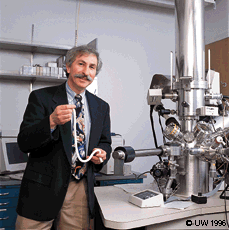


"We know the human body has the capacity to heal wounds. What we hope to do is develop a new generation of implanted medical devices made of biomaterials that are recognized by cells in the body and that actively trigger the natural healing process."
The potential for improving patient care is staggering, according to Harborview Surgery Professor Timothy Pohlman, co-investigator in the biomaterials project.
Every year, doctors implant more than a half billion medical devices in patients, only to watch the body's natural defenses render many of the implants useless. Vascular grafts used to bypass clogged arteries almost always become blocked with scar tissue. Orthopedic hips and knees used to replace joints often become loose and incapable of supporting weight. And catheters--used to deliver drugs or fluids intravenously and by far the most common medical implant--become infected and have to be removed.
UW researchers hope to examine what's happening at the molecular level to cause these problems, as well as what occurs in normal healing. Once they understand the molecular process, they can cultivate new bionic biomaterials for making medical implants that promote healing. If the body's natural reaction to foreign materials is overcome, Pohlman says, doctors and scientists envision treatments for a host of maladies that today disrupt or destroy people's lives.
An implantable glucose monitor could continuously monitor blood-sugar levels in diabetics so they no longer have to do finger-prick tests several times a day or risk the debilitating results of insulin imbalances. Patients with kidney failure, who now have to be hooked up to a dialysis machine on a regular basis to clean their blood while they wait for a kidney transplant, could have a small dialysis machine implanted in their body. They would no longer need a transplant. And Bo Jackson, whose budding NFL career came crashing to a halt when he had to have hip replacement surgery, could return to the football field again with an artificial joint every bit as strong as the real one.
"If you let your mind wander, the opportunities to restore life or function for patients is endless," Pohlman says. "I think some of the most discouraged patients we see are those who have had medical devices that fail. I'm very excited about the potential of UWEB to tackle some of the fundamental problems of implants."
A New Generation of Engineers
Turning Off the Body's Defense
One Molecule at a Time
Denice Denton: A New Kind of Dean
Send a letter to the editor at columns@u.washington.edu.